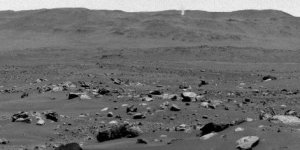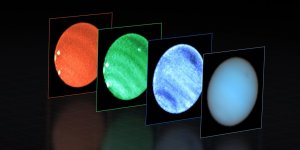| News / Space News |
NASA’s Lucy Spacecraft Preparing for its First Asteroid Flyby
NASA’s Lucy spacecraft is preparing for its first close-up look at an asteroid. On Nov. 1, it will fly by asteroid Dinkinesh and test its instruments in preparation for visits in the next decade to multiple Trojan asteroids that circle the Sun in the same orbit as Jupiter.

This diagram illustrates Lucy's orbital path. The spacecraft’s path (green) is shown in a frame of reference where Jupiter remains stationary, giving the trajectory its pretzel-like shape. After launch in October 2021, Lucy has two close Earth flybys before encountering its Trojan targets. In the L4 cloud Lucy will fly by (3548) Eurybates (white), (15094) Polymele (pink), (11351) Leucus (red), and (21900) Orus (red) from 2027-2028. After diving past Earth again Lucy will visit the L5 cloud and encounter the (617) Patroclus-Menoetius binary (pink) in 2033. As a bonus, in 2023, before the second Earth gravity assist, and again in 2025 on the way to the L4, Lucy flies by two small main belt asteroids, (152830) Dinkinesh (white), named for the Amharic name of the Lucy fossil, and (52246) Donaldjohanson (white), named for the discoverer of the Lucy fossil. Photo: Southwest Research Institute
Dinkinesh, less than half a mile, or 1 kilometer, wide, circles the Sun in the main belt of asteroids located between the orbits of Mars and Jupiter. It will be the first of 10 asteroids Lucy will visit on its 12-year voyage. To observe so many, Lucy will not stop or orbit the asteroids, instead it will collect data as it speeds past them in what is called a “flyby.”
The primary aim of the Lucy mission, which launched Oct. 16, 2021, is to survey the Jupiter Trojan asteroids, a never-before-explored population of small bodies that orbit the Sun in two “swarms” that lead and follow Jupiter in its orbit. However, before Lucy gets to the Trojans, it will fly by another main belt asteroid in 2025 called Donaldjohanson for additional in-flight tests of the spacecraft systems and procedures.
During the Dinkinesh flyby, the team will test its terminal-tracking system that will allow the spacecraft to autonomously pinpoint the location of the asteroid, keeping it within the instruments’ field-of-view throughout the encounter.
As this encounter is intended as a test of Lucy’s systems, scientific observations will be simpler than for the mission’s main targets. The spacecraft and the platform that holds the instruments will move into position two hours before the closest approach to Dinkinesh.
Once in place, the spacecraft will begin collecting data with its high-resolution camera (L’LORRI) and its thermal-infrared camera (L’TES).
One hour before closest approach, the spacecraft will begin tracking the asteroid with the terminal-tracking system. Only in the last eight minutes will Lucy be able to collect data with MVIC and LEISA, the color imager and infrared spectrometer that comprise the L’Ralph instrument.
Lucy’s closest approach is expected to occur at 12:54 p.m. EDT, when the spacecraft will be within 270 miles (430 kilometers) of the asteroid. Lucy will perform continuous imaging and tracking of Dinkinesh for almost another hour. After that time, the spacecraft will reorient itself to resume communications with Earth but will continue to periodically image Dinkinesh with L’LORRI for the next four days.
“We’ll know what the spacecraft should be doing at all times, but Lucy is so far away it takes about 30 minutes for radio signals to travel between the spacecraft and Earth, so we can’t command an asteroid encounter interactively,” said Mark Effertz, Lucy chief engineer at Lockheed Martin Space in Littleton, Colorado.
“Instead, we pre-program all the science observations. After the science observations and flyby are complete, Lucy will reorient its high-gain antenna toward Earth, and then it will take nearly 30 minutes for the first signal to make it to Earth.”
After the Dinkinesh encounter, the Lucy spacecraft will continue in its orbit around the Sun, returning to the Earth’s vicinity for its second gravity assist in December 2024.
This push from Earth will send it back to the main asteriod belt for its 2025 Donaldjohanson flyby, and then on to the Jupiter Trojan asteroids in 2027.
YOU MAY ALSO LIKE





